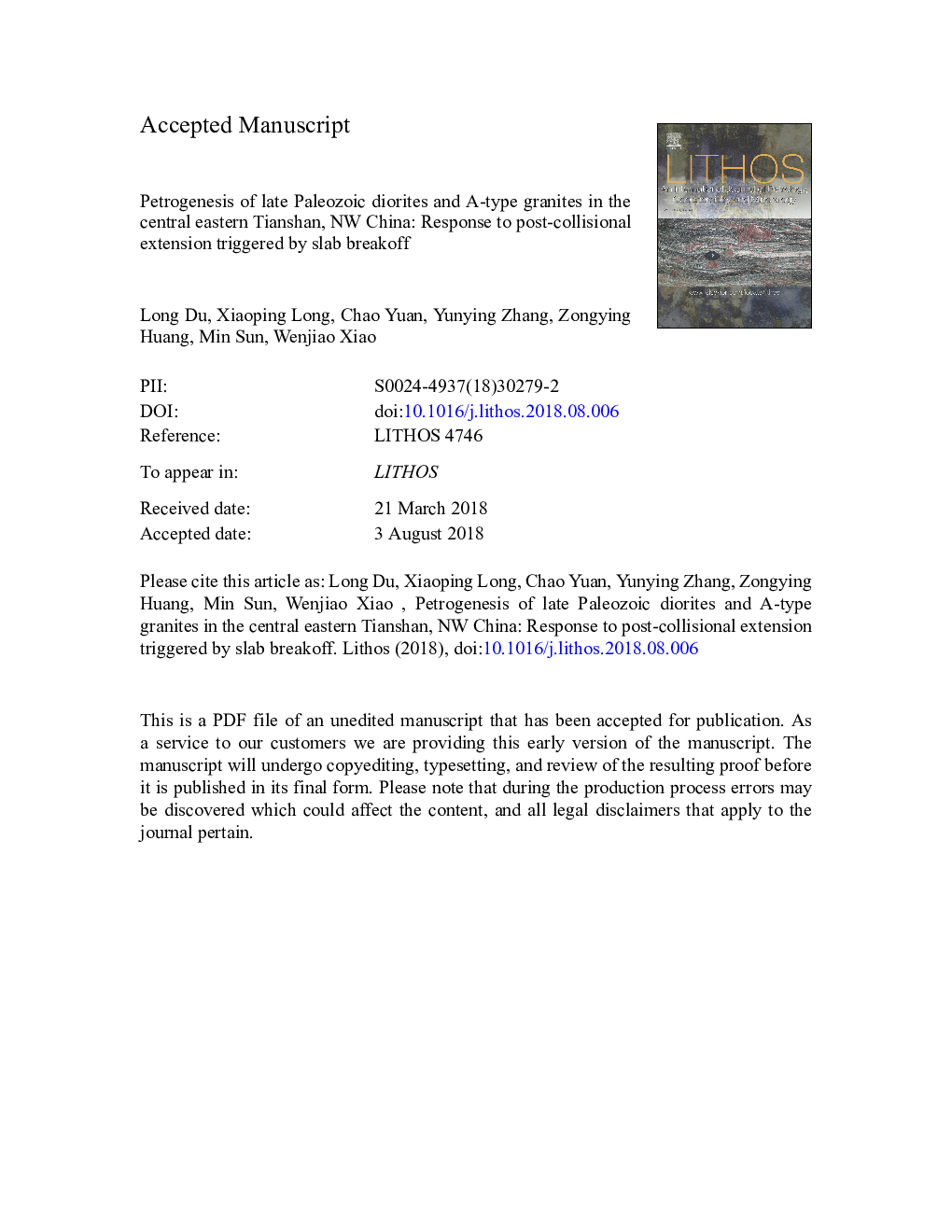| کد مقاله | کد نشریه | سال انتشار | مقاله انگلیسی | نسخه تمام متن |
|---|---|---|---|---|
| 8911494 | 1638615 | 2018 | 57 صفحه PDF | دانلود رایگان |
عنوان انگلیسی مقاله ISI
Petrogenesis of Late Paleozoic diorites and A-type granites in the central Eastern Tianshan, NW China: Response to post-collisional extension triggered by slab breakoff
دانلود مقاله + سفارش ترجمه
دانلود مقاله ISI انگلیسی
رایگان برای ایرانیان
کلمات کلیدی
موضوعات مرتبط
مهندسی و علوم پایه
علوم زمین و سیارات
ژئوشیمی و پترولوژی
پیش نمایش صفحه اول مقاله

چکیده انگلیسی
Geological evolution of the Eastern Tianshan in the Late Paleozoic is significant to understanding the multiple accretions and final formation of the southern Central Asian Orogenic Belt. Here, we report new whole-rock geochemical and Sr-Nd isotopic data, and in situ zircon U-Pb ages for three typical A-type granitic intrusions (syenogranite, K-feldspar granite and monzonitic granite) and one dioritic pluton in the central Eastern Tianshan, NW China, in order to constrain their petrogenesis, tectonic setting and geodynamic evolution. Zircon LA-ICP-MS U-Pb ages indicate that the syenogranites and K-feldspar granites were both formed during a short time interval in the Early Permian (284-286â¯Ma), whereas the diorites were crystallized at 293â¯Â±â¯6â¯Ma. The monzonitic granites were generated at 307â¯Â±â¯3â¯Ma, earlier than the other two granitic intrusions. The three kinds of granites (syenogranite, K-feldspar granite and monzonitic granite) have high HFSE, HREE and Y/Nb ratios (1.68-2.84), and remarkably low Sr and Ba contents, with the absence of aluminium-rich minerals and show metaluminous to weakly peraluminous natures, indicating geochemical characteristics of aluminous A2-type granites. These granites show negative εNd(t) (â3.32 to â4.40) values and Mesoproterozoic two stage Nd model ages (TDM2â¯=â¯1.36 to 1.43â¯Ga), which suggest a relatively old crustal source for these rocks. The Sr-Nd isotopic compositions imply that the Mesoproterozoic metamorphic basement of the Central Tianshan Block can be considered as a potential magmatic source for these aluminous A2-type granites. In addition, they have geochemical characteristics similar to the experimental melt that was derived from partial melting of crustal metaigneous rocks at the depth of middle to lower crust levels. Therefore, the granites were most likely produced by partial melting of metaigneous rocks in a post-collisional extensional setting. The diorites have low SiO2 and high MgO, with uniform (87Sr/86Sr)i values (~0.7055), negative εNd(t) values (â4.11 to â4.59) and Mesoproterozoic two stage Nd model ages (TDM2â¯=â¯1.41 to 1.45â¯Ga). They have higher Ti/Zr (42.8-46.7) and Ti/Y (280-359) ratios than continental crust and show negative Nb-Ta-Ti anomalies, which can be explained by partial melting of a relatively fertile mantle modified by old crustal materials of the Central Tianshan Block. The formation of the dioritic pluton was induced by an upwelling asthenosphere in an extensional geodynamic setting. Based on the zircon saturation temperatures of these A-type granites and the distribution of Late Carboniferous to Early Permian mantle-derived intrusions, a slab breakoff model is suggested to interpret the formation of the studied A-type granites and diorites. We infer that the slab breakoff was initiated in the Late Carboniferous and ended in the Early Permian.
ناشر
Database: Elsevier - ScienceDirect (ساینس دایرکت)
Journal: Lithos - Volumes 318â319, October 2018, Pages 47-59
Journal: Lithos - Volumes 318â319, October 2018, Pages 47-59
نویسندگان
Long Du, Xiaoping Long, Chao Yuan, Yunying Zhang, Zongying Huang, Min Sun, Wenjiao Xiao,